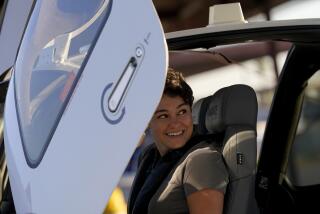FAA Will Discourage Future Record Flights by Children
The Federal Aviation Administration will try to discourage future record-breaking flights by children, such as Tony Aliengena’s 22,000-mile, globe-circling trip earlier this summer, a high-ranking FAA official said Friday.
“People do it for the publicity,” said Gabe Bruno, general manager of the FAA’s general aviation operations branch in Washington. “It leaves the public with the impression that there are a bunch of kids flying around out there, and that’s simply not the case.”
Tony, 11, of San Juan Capistrano, and his father, Gary, an experienced pilot who accompanied him on the “Friendship Flight,” were vacationing with other family members in Utah on Friday and could not be reached for comment.
Their trip, which involved stops in seven countries, including the Soviet Union, began June 5 and ended July 22 at John Wayne Airport, with Tony becoming the youngest person to pilot a plane around the world.
Earlier this week, the state Senate unanimously passed a resolution honoring Tony for his “courage” in piloting the single-engine Cessna.
But the flight generated considerable controversy, with many commercial and general aviation pilots arguing that because Gary Aliengena was aboard, coaching his son, the feat was drawing undue attention and was undercutting public confidence in air safety.
In June, for example, a Seattle pilot wrote to the FAA to criticize the Aliengenas’ flight as an unsafe “publicity stunt.” FAA Acting General Aviation Manager Louis C. Cusimano’s written reply stated:
“We are concerned that these recent flights by youngsters may have served to reduce public confidence in the safety of the aviation system. Therefore, we will be actively working with general aviation organizations and flight instructors to discourage such actions in the future.”
The correspondence, written in June, was obtained this week by The Times under the U.S. Freedom of Information Act.
Cusimano was unavailable Friday, but Bruno, his deputy, said that the FAA is simply encouraging aviation organizations to take a second look at flights by children, because federal laws do not currently allow the agency to totally ban such flights as long as a licensed pilot, such as Tony’s father, is aboard and takes responsibility.
“This type of flight has not created a problem until the last couple of years,” Bruno said. “In all the cases that we know of, proper procedures have been followed. I wouldn’t say that there’s a safety issue here--it’s an image type of thing. It leaves the public with the wrong impression.”
General aviation pilots and their organizations generally supported the FAA’s position.
“There are a lot of educational opportunities for youngsters interested in aviation,” said Frank White, director of public affairs for the 295,000-member Aircraft Owners and Pilots Assn., the world’s largest pilots’ group. “We prefer to see those opportunities explored through more legitimate channels, such as the Aviation Explorer program and the Boy Scouts. These flights by young people tend to trivialize the flight instruction process.”
Gregory Wilcox, 34, a pilot at Martin Aviation at John Wayne Airport, said the FAA’s latest stance is “as it should be.”
“The whole thing was made too much of to begin with,” said Wilcox, who got his pilot’s license at 17, the minimum age. “It’s a great adventure for Tony. . . . But it gives the public the feeling that inexperienced people are playing around in the air system, and that’s not a good idea.”
But not all aviation experts agreed.
Vi Smith, an aviation author and historian who helped Martin Aviation prepare for the Aliengenas’ departure from and return to John Wayne Airport, attributed the FAA’s statements to negative reaction “from an uninformed public.”
While acknowledging that some reporters pointed out how Gary Aliengena was actually in charge during “Friendship Flight,” Smith said such information was not repeated strongly or often enough.
The FAA said Friday that it is still investigating the July 18 crash of the Aliengenas’ plane in Golovin, Alaska. The crash occurred with Tony’s father at the controls during an impromptu fishing trip during a break in the flight around the world. Initially, Gary Aliengena said he didn’t know what caused the crash. But a day later he told FAA investigators that he had mistaken a taxiway for the runway and did not have enough room or speed to become airborne. The Cessna ended up in a ditch.
More to Read
Inside the business of entertainment
The Wide Shot brings you news, analysis and insights on everything from streaming wars to production — and what it all means for the future.
You may occasionally receive promotional content from the Los Angeles Times.










